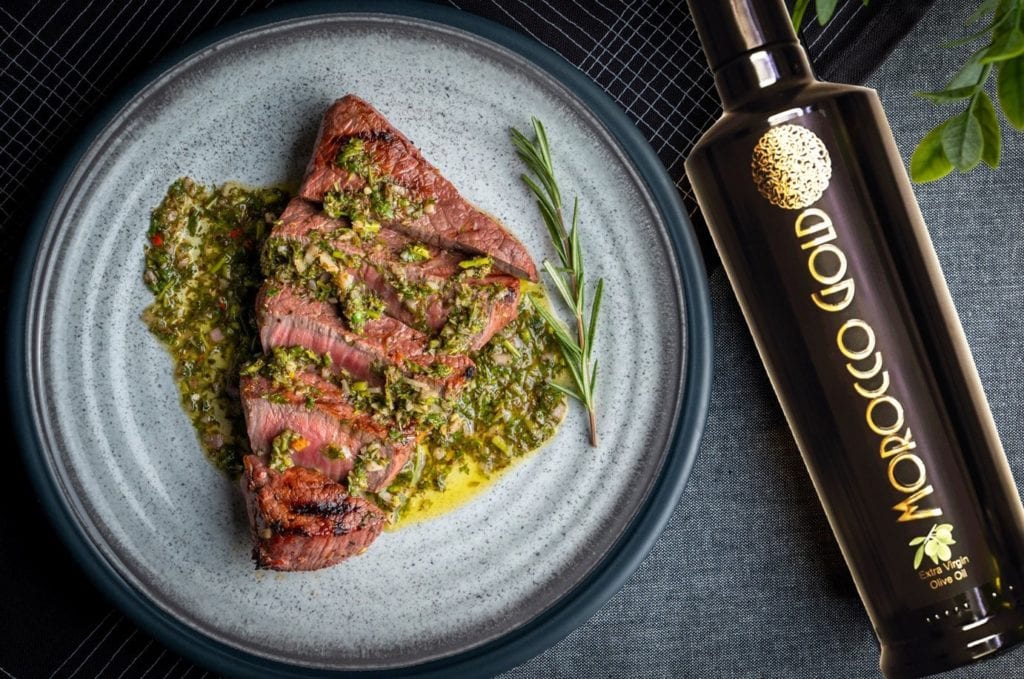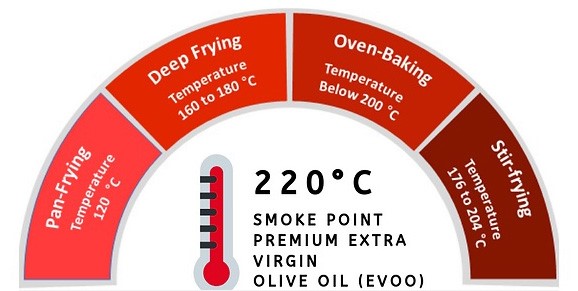Why there is no need to stress about the smoke point of extra virgin olive oil when cooking.
Updated 11th January 2023

Summary:
- According to The Mediterranean Dish, Extra virgin olive oil has a smoke point of between 374 and 405 degrees F (190 to 207 degrees C).
- Good quality extra virgin olive oil (EVOO) will also have a higher smoke point than its lower-quality counterparts.
- Morocco Gold Extra Virgin Olive Oil is a great choice for many cooking methods as its smoke point is somewhere around 374 – 405 °F (190–207°C).
- Olive Wellness Institute, explains extra virgin olive oil (EVOO) contains high levels of natural antioxidants.
- Antioxidants In Extra Virgin Olive Oil protect the naturally stable oil when heated.
- Extra Virgin Olive Oil a very health option to cook with, including deep frying, pan frying, sauteing and oven baking.
Contents:
- What Is The Smoke Point Of Extra Virgin Olive Oil (EVOO)?
- Extra Virgin Olive Oil (EVOO) Is The Highest Grade Of Olive Oil.
- Extra Virgin Olive Oil: Myths Vs Facts
- Olive Oil Smoke Point: What Does That Mean?
- What’s In A Bottle Of Extra Virgin Olive Oil (EVOO)?
- Antioxidants In Extra Virgin Olive Oil (EVOO)
Cooking With Extra Virgin Olive Oil: Don’t Fear The Smoke Point
While extra virgin olive oil has many health benefits thanks to its high antioxidant levels, its reputation of smoking or burning at high heat has caused many home cooks to shy away from heating it up.
However, that smoke you see releasing from the pan doesn’t necessarily mean the oil has gone bad or you need to toss it and start over. In this post, I’ll explain the facts about extra virgin olive oil’s smoke point and debunk some common myths around using this healthy oil for cooking so you can feel comfortable bringing out its flavor in recipes without fear of ruining your meal.
What Is The Smoke Point Of Extra Virgin Olive Oil (EVOO)?
When cooking with extra virgin olive oil (EVOO) the temperature at which smoke starts to appear is called the smoke point. It is just one of the factors used to determine which oils are best for cooking with.
However, the smoke point of extra virgin olive oil (EVOO) is not a single number. Rather it is a range of temperatures within which smoking may start. Different types or grades of olive oil have their own smoke point. That’s because their chemical properties vary significantly.
High quality extra virgin olive oil (EVOO) has a higher smoke point than others. It ranges roughly between 190 to 220°C (375 to 430°F). That’s because it is low in free fatty acids (FFA) and the smoke point of an oil generally increases as the FFA content decreases. This low acid content puts it at the top of preferred cooking oils.
Cooking exposes food to a variety of temperatures:
- Pan frying (sauté): on stove top heat 120°C (248 °F)
- Deep frying: 160 to 180°C (320 to 356 °F)
- Oven baking: below 200 °C (392 °F), and often no more than 180°C (about 360 °F)
- Stir-frying: 176 to 204 °C (350°F to 400°F)

Premium extra virgin olive oil (EVOO) suits all normal home cooking methods. Extra virgin olive oil (EVOO) has a reasonably high smoke point which is generally above the standard temperatures required for cooking. Even better is to cook with premium quality extra virgin olive oil (EVOO) due to its even lower FFA which results in an actual smoke point in the upper end of the range.
Extra Virgin Olive Oil (EVOO) Is The Highest Grade Of Olive Oil.
Among natural olive oils, extra virgin olive oil (EVOO) has the lowest FFA content of no more than0.8%. Really premium quality extra virgin olive oil (EVOO) like Morocco Gold has FFA content as low as 0.2 to 0.4%. It results from fresh, healthy olive fruit, which are carefully handled, harvested, and freshly milled to minimize deterioration of the fruit. By comparison, chemically refined oils, such as Canola oil, may have similar FFA levels but they are processed and refined. They do not provide the superb health benefits that extra virgin olive oil (EVOO) does. In addition, the high levels of monounsaturated and polyunsaturated fats in extra virgin olive oil (EVOO) also make it ideal for all types of cooking.
There is no doubt that when food is cooked with extra virgin olive oil (EVOO) it is healthier than if cooked with other oils. Extra virgin olive oil (EVOO) also enhances the flavors of food cooked in it. It cooks food quickly because it conducts hotter temperatures into the inside of the food.
By comparison, Canola oil is heavily refined and mostly GMO. Refining markedly lowers the nutrients in oils, such as essential fatty acids, antioxidants, and vitamins.
Temperature and time are the key elements in cooking. They are also very important when using cooking oils. Just as food can get burnt, so can cooking oil when it gets too hot. At very high temperatures oils break down. That means their chemical formulation changes and undesirable compounds can be created. They lose much of their nutritional value and can give the food an unpleasant flavor. That’s one of the important things about the smoke point – you don’t want to be cooking with burnt oil.
What Type Of Cooking Is Best With Extra Virgin Olive Oil (EVOO)?
Extra virgin olive oil is nothing more than pure juice of the olive. No chemicals have been added and it has not been blended with lower quality oils. It’s the best that olive oil you can get. Its high smoke point means it is perfect for high-temperature cooking such as stir-frying or any of these methods:
- Grilling/broiling / barbecuing – used to coat cuts like steaks or chops
- Shallow frying – cooking in a little oil for pan fry, sauté, griddle, stir fry
- Deep frying – submerging the food in hot oil
- Roasting – for coating vegetables or joints
- Baking – adds great flavor to breads
Extra Virgin Olive Oil: Myths Vs Facts
A lot of “health experts” argue that high-quality olive oil should not be used in cooking. The persisting myth goes that high heat will ruin some of olive oil’s health benefits. But is this true? As more research is undertaken in this are the answer is – yes, you can cook with extra virgin olive oil and yes – it is safe and beneficial to your health. There are many aspects that determine if a certain oil is safe for cooking. While olive oil is generally resistant to heat, some oxidation will happen. However, this is still preferable to other cooking oils. Let’s discover why!
Olive Oil Smoke Point: What Does That Mean?
The smoke point is the temperature at which oil starts emitting a bluish smoke. It’s not the smoke that should bother you, though. Heated past their smoke point, oils begin to break down. They react with the oxygen in the atmosphere and free radicals are produced. Not only does this ruin the flavour, but it is also potentially harmful, even cancer-causing to humans.
What’s In A Bottle Of Extra Virgin Olive Oil (EVOO)?
The free fatty acids (FFA – normally measured as oleic acid) in extra virgin olive oil are extremely important. The amount of free fatty acids (FFA) determines how acidic the oil will be. This has two important consequences:
- The more acidic an oil is, the lower the smoke point (a.k.a. the olive oil will be more susceptible to chemical damage)
- Extra virgin olive oil, which has the lowest FFA of all olive oils, is the best for high-heat cooking
The free fatty acids are not the only thing that determines the olive oil smoke point. They only make up only around up to 1% of the oil. There are three types of fatty acids. These depend on the bonds between carbon atoms in their molecule. Depending on these bonds, fats can be:
- Saturated – they only have single bonds between carbon atoms. It’s very hard for them to react with other compounds because single bonds are strong and difficult to break down.
- Monounsaturated – there is only one double (or triple) bond in the entire molecule. The second bond is easier to break down. However, since monounsaturated fats have a fairly large molecule, the compound as a whole is not very reactive.
- Polyunsaturated – unsurprisingly, these fatty acids have multiple double/triple bonds. This makes them much more vulnerable to reactive substances.
Olive oil is rich in monounsaturated fats. These fats are fairly stable. They need very high heat to make them react with oxygen. This means the olive oil smoke point goes up – at low temperatures, monounsaturated fats are not reactive and will not break down.
Antioxidants In Extra Virgin Olive Oil (EVOO)
The third big reason while the extra virgin olive oil smoke point is so high has to do with antioxidants. The major reason why heat ruins oils is it makes them react with oxygen. Olive oil is already very resistant to that because it’s rich in monounsaturated fats. To top this off, olive oil is also rich in antioxidants. The antioxidant content of this oil makes it even more stable. These compounds pick up reactive oxygen radicals. This way, even at a high heat, the overall reactivity of olive oil is reduced. Or, in simpler words:
Antioxidants prevent olive oil from changing structure even in high heat.
In Conclusion
In short: Keep your eye on the frying pan for tell-tale wisps of smoke. They signal you’re close to burning the oil, but not quite at the so-called smoke point where the extra virgin olive oil (EVOO) begins to break down.
According to Kathy McManus, director of the department of nutrition at Boston’s Brigham and Women’s Hospital:
The reason you want to avoid burning the oil is that it will spoil the taste of the food, and some of the extra virgin olive oil (EVOO’s) healthy properties may be destroyed.
Kathy McManus, Boston’s Brigham and Women’s Hospital
As we’ve noted, extra virgin olive oil EVOO is very suitable for cooking. Its chemical structure and its healthful antioxidants protect the oil from heat during cooking.
According to experts, a high-quality extra virgin olive oil (EVOO) has a smoke point of around 410 degrees Fahrenheit. That makes extra virgin olive oil fine for sautéing, roasting, frying and even deep frying.
“Extra virgin olive oil is really pretty resilient,” said Bill Briwa, a senior chef-instructor at the Culinary Institute of America’s campus in California’s Napa Valley at a cooking demonstration on healthy eating and living conference at the Napa campus.
He was preparing to sauté green beans in extra virgin olive oil (EVOO) during a cooking demonstration while offering advice on how to avoid burning your oil:
When you see the first few wisps of smoke that tells you the oil is the hottest it can get before you burn it, you then have two choices. You can take the pan off the heat. Or you can add some food.
Chef Briwa
